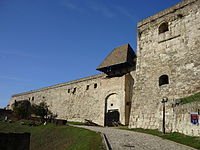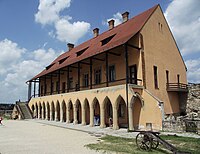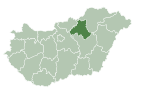Eger
This article includes a list of general references, but it lacks sufficient corresponding inline citations. (September 2011) |
Eger | |
|---|---|
City with county rights | |
| Eger Megyei Jogú Város | |
 Top left: Eger Minorite church. Top right: View of Eger from the castle. Bottom left: Egri Bazilika. Bottom right: Minaret Eger | |
|
UTC+2 (CEST) | |
| Postal code | 3300 – 3304 |
| Area code | (+36) 36 |
| Website | varos |
Eger (
Names and etymology
The origin of its name is unknown. One suggestion is that the place was named after the
The other names of the town are in
Coat of arms

The shield of Eger developed from the shield of
History
Eger has been inhabited since the Stone Age.
Reign of Saint Stephen

Today's Eger was formed in the 10th century by St.
This settlement took up an important place among the Hungarian towns even in the early Middle Ages. The natural fundamentals of the surroundings (meeting of plains and hills) made it possible to establish economic and cultural relations between the different parts of the country.
During the 11th and 12th centuries, Walloon settlers came from the areas beyond the Rhine. They settled with the kings' permission, bringing western culture to this region and acclimating the viticulture. The development of the town accelerated with their presence.
Mongol invasion

This development was blocked for a short time by the Mongol invasion in 1241, when the town was ransacked and burned down during the episcopacy of Cletus Bél.
After the withdrawal of the
Reign of King Matthias


During the reign of
The siege of Eger


After the
Despite the fact that István Dobó and his soldiers successfully defended the fortress, it was destroyed during the siege, so it was essential to wholly rebuild it. The reconstruction process of the fortress took place between 1553 and 1596 and Italian artificer officers planned the renovations. The famous Hungarian poet, Bálint Balassi also served here for a few years beginning in April 1578.
Ottoman rule


While
The rule of the Turks in
Habsburg rule




After the expelling of the Turks, the town was considered by the imperial regiment as a demesne of the Crown. Leopold I re-established Eger as a free royal borough in 1688, which meant that it was relieved from the ecclesiastic manorial burdens. This state lasted until 1695, when Fenessy György, the returning bishop, had the former legal status of a bishopric town restored by the monarch.
Eger soon began to prosper again. The town was reclaimed by its bishops, which caused many local
In the history of Eger, the 18th century was the period of development and prosperity. Many new buildings were built in Baroque and later in Rococo and Neoclassical style, including the cathedral, the Archiepiscopal Palace of Eger, the County Hall of Eger, the Eger Lyceum (now housing the Eszterházy College of Education) and several churches, while others were reclaimed from being mosques.
The building processes attracted many craftsman, merchants, and artists, including
The 18th century was also important because bishop
The 19th century began with disasters: a fire that destroyed half the town in 1800, and a collapse of the south wall of the Castle in 1801, which ruined several houses. Eger became the seat of an
In 1804, a significant change occurred in the organisation of Eger's bishopric. The monarch made this town a centre of archbisphoric, but the bishoprics of Szatmár and Kassa separated from it.
The Period of Reforms
The Period of Reforms (1825–1848) left several lasting marks on the life of Eger, especially on its culture. Pyrker László János, the archbishop of that time, founded a gallery which he donated to the Hungarian National Museum because the town did not guarantee an appropriate place for it. It was Pyrker's present which served as a base for the collection of the Museum of Fine Arts that was opened in 1900. In 1828 Pyrker established the first Hungarian teachers training college in Eger and he was the one who ordered the construction of the basilica which was built in neo-classical style, in accordance with the plans of József Hild. On the basis of its size, this basilica is the second among the churches of Hungary. In 1837, János Joó, an art teacher, began to edit Hungary's first technical journal with the title "Héti Lapok".

Revolution and War of Independence
The inhabitants of Eger took an active part in the
Age of the monarchy
The main railway line between Miskolc and Pest bypassed the town, which was only reached later by a branch line from Füzesabony. Unfortunately (unlike other towns) Eger's civil development did not become faster, as distinguished from other towns, after 1849 and the Compromise of 1867. Industrial development was represented only by the mill, the tobacco factory and the sheet-iron works that were founded in the Reform Age.
During the decades after the turn of the century, the character of a school-town was dominant in Eger. Because of its schools and other cultural institutions, it became known as the Hungarian Athens.
At the beginning of the century, in 1904, the first independent theatre of stone was opened and the canalisation and the provision of public utilities began as well.
20th century

Economic recovery was slow after World War I, although the 1899 publication of Gárdonyi's "Eclipse of the Crescent Moon" made Eger popular as a tourist attraction and archaeological excavation of the castle resumed.
In 1933, Eger was one of those towns that first got the permission for opening a spa.
In 1910, 2,674 Jews lived in the village but in 1944 the Jewish community was murdered by Hungarians and Germans during the
In
In the decades after 1945, industrialization of the town commenced because of the change of regime. As a consequence, Eger's former character of a cultural centre began to fade, which diminished the patina of the settlement.
It was of great fortune that in 1968 the baroque inner city was preserved. It was saved from the deterioration (and from the construction of unsuitable, modern buildings).

Eger is famous for its wines, most notably the "Egri Bikavér" (Bull's Blood of Eger). It is also well known for "Egri Víz", a type of brandy which originated in the 18th century, the "bujavászon" (a special Turkish tissue), as well as its thermal baths. Today, Eger is a prosperous town and popular tourist destination with a charming Baroque town centre.
Ecclesiastical history

Eger is the seat of the
Geography
Climate
Eger has a humid continental climate (Köppen: Dfb) closely bordering on a oceanic climate (Cfb) or humid subtropical climate (Cfa). The annual average temperature of Eger is 10.8 °C (51.4 °F), and the warmest July has an average temperature of 21.6 °C (70.9 °F), while January is the only month below freezing, with an average temperature of −0.8 °C (30.6 °F).[8] The annual precipitation is 583.4 millimetres (22.97 in), of which January is the month with the least precipitation at 25.7 millimetres (1.01 in), while July is the month with the most precipitation at 82.9 millimetres (3.26 in). Temperature extremes ranged from −18.3 °C (−0.9 °F) on January 13, 2003 to 38.6 °C (101.5 °F) on July 20, 2007.[8]
| Climate data for Eger, 1991−2020 normals | |||||||||||||
|---|---|---|---|---|---|---|---|---|---|---|---|---|---|
| Month | Jan | Feb | Mar | Apr | May | Jun | Jul | Aug | Sep | Oct | Nov | Dec | Year |
| Record high °C (°F) | 15.3 (59.5) |
18.2 (64.8) |
23.2 (73.8) |
29.7 (85.5) |
32.1 (89.8) |
36.5 (97.7) |
38.6 (101.5) |
37.4 (99.3) |
34.0 (93.2) |
27.0 (80.6) |
22.3 (72.1) |
13.8 (56.8) |
38.6 (101.5) |
| Mean daily maximum °C (°F) | 2.4 (36.3) |
5.3 (41.5) |
10.8 (51.4) |
17.2 (63.0) |
21.9 (71.4) |
25.4 (77.7) |
27.6 (81.7) |
27.7 (81.9) |
22.1 (71.8) |
15.9 (60.6) |
9.0 (48.2) |
2.8 (37.0) |
15.7 (60.3) |
| Daily mean °C (°F) | −0.8 (30.6) |
1.2 (34.2) |
5.9 (42.6) |
11.7 (53.1) |
16.0 (60.8) |
19.7 (67.5) |
21.6 (70.9) |
21.5 (70.7) |
16.4 (61.5) |
10.9 (51.6) |
5.5 (41.9) |
0.0 (32.0) |
10.8 (51.4) |
| Mean daily minimum °C (°F) | −3.5 (25.7) |
−2.2 (28.0) |
1.5 (34.7) |
6.5 (43.7) |
10.8 (51.4) |
14.1 (57.4) |
15.8 (60.4) |
15.7 (60.3) |
11.6 (52.9) |
6.7 (44.1) |
2.5 (36.5) |
−2.5 (27.5) |
6.4 (43.5) |
| Record low °C (°F) | −18.3 (−0.9) |
−17.9 (−0.2) |
−12.1 (10.2) |
−4.2 (24.4) |
−0.8 (30.6) |
4.7 (40.5) |
5.9 (42.6) |
5.7 (42.3) |
2.2 (36.0) |
−7.7 (18.1) |
−11.9 (10.6) |
−17.2 (1.0) |
−18.3 (−0.9) |
| Average precipitation mm (inches) | 25.7 (1.01) |
30.5 (1.20) |
27.9 (1.10) |
42.5 (1.67) |
63.5 (2.50) |
70.9 (2.79) |
82.9 (3.26) |
64.4 (2.54) |
48.7 (1.92) |
46.4 (1.83) |
43.5 (1.71) |
36.5 (1.44) |
583.4 (22.97) |
| Average precipitation days (≥ 1.0 mm) | 5.7 | 5.9 | 5.9 | 6.8 | 9.0 | 8.3 | 8.5 | 6.7 | 6.0 | 6.1 | 6.8 | 7.0 | 82.7 |
| Average relative humidity (%)
|
82.1 | 75.2 | 63.4 | 58.4 | 63.8 | 64.4 | 63.5 | 62.3 | 67.6 | 74.0 | 80.0 | 83.4 | 69.8 |
| Mean monthly sunshine hours | 71.9 | 93.9 | 162.6 | 208.0 | 255.3 | 256.4 | 282.2 | 268.8 | 184.2 | 147.6 | 83.3 | 57.0 | 2,071.2 |
| Source 1: OMSZ (sun 1991-2020)[9] | |||||||||||||
| Source 2: NOAA[8] | |||||||||||||
Wine

Beside its historic sights and its thermal baths, Eger is famous for its
Tourism
The majority of visitors come for a single day (mostly from
) as well. However, the town is getting more popular for Turkish tourists, because of the common historical memories. Eger is mainly known for its castle, thermal baths (including an Olympic size swimming pool), historic buildings (including Eger minaret - the northernmost Turkish minaret) and, above all else, its famous Hungarian red wines.Transport
Rail

The main railway station is located 1.5 km from the town centre.

There are also smaller stations located near the
Coach
The bus station is located close to the basilica. Buses depart approx. every 30 minutes to Budapest, and the trip to the capital is about 2 hours. Volánbusz operates an extensive network of suburban and long-distance buses. Other bus companies also offer connections to a variety of destinations. Taking the bus to Felsőtárkány gets you close to several hiking and mountain biking trails.
Local bus
Volánbusz also operates a fleet of local buses, serving most parts of the town, although the majority of buses run in a north–south direction. Line 12 is the busiest line in the town, and it has stops at the railway station, the bus station and in the town centre.
Culture

Districts


(Note: Most of these districts are historical, but they often appear on maps and street signs.)

- Almagyar – This hill in the eastern part of the town is one of the smart areas of Eger, near the castle. The streets are steep, but there are fine views. The southern part contains some of the buildings (campus and dormitories) of Eszterházy College.
- Almár – The northernmost part of the town, it consists mainly of weekend cottages and plots for gardeners.
- Belváros (town centre) – The centre of Eger is often called "the Baroque Pearl of Europe". Here are located Dobó tér, the main square of the historical town, surrounded by Baroque houses and St. Anthony's Church. Other historic buildings nearby include the Cathedral and the Lyceum.
- Berva is now a housing estate about 2 km to the NW of Eger. Founded in 1951, it was a huge industrial park by the name of Finomszerelvénygyár, privatized in 1992.
- Castle of Eger– The oldest and most famous part of Eger.
- Cifra hóstya – North of the centre, this part of town is full of small houses and narrow streets. You can find the Firefighters' Museum there.
- Csákó – a suburban area with larger houses, east of the railway station.
- Érsekkert(Bishop's Garden) – The largest park in Eger, with sport facilities, a small lake, and a fountain.
- Felnémet – This village, north of the town, was annexed to Eger in 1961 but still has a rural character. The parish church (1715–1750s, designed by Gianni Battista Carlone, an Italian who settled in Eger) was started by Bishop Gábor Antal Erdődy as a votive church after an outbreak of bubonic plague in 1710, and completed by his successor. It was dedicated to St. Rosalia, a guardian against plague.
- Felsőváros (Upper Town), formerly Csebokszári (Chuvash Republic, Russia) – The largest housing estate of Eger, it is full of four and ten-storied concrete buildings, providing homes for one third of the town's population. There are three high schools there.
- Hajdúhegy – a suburban area similar to Almagyar across the valley with downtown being in between these 2 hills.
- Hatvani hóstya – The district is split by Highway 25. It contains the stadium and the Reformed church.
- Industrial zone – Several multinational companies have moved into this area east of Lajosváros.
- Károlyváros (Charles Town) – One of the largest districts of Eger, Károlyváros is west of downtown. It contains the High School for the Health Professions, and the Agria Park Shopping Mall.
- Lajosváros (Louis Town) – This district in the southern part of the town has several high schools and student hostels. It consists mainly of detached houses. Also called Kanada.
- Maklári hóstya, Tihamér – This district is one of the fastest developing parts of the town. It contains public swimming pools (designed by Imre Makovecz).
- Pásztorvölgy – A suburban area in Felnémet. Also has a high school.
- Rác hóstya – Another suburban area west from Upper Town.
- Szépasszonyvölgy ("Valley of the Beautiful Woman") – An area of Eger famous for its red wines (Bikaver or Bulls Blood) and known for its wine cellars.
- Tetemvár – Another suburban area. The name ("Corpses' Castle") derives from the legend that Turkish war dead were buried here in 1552.
- Vécseyvölgy – A suburban area with a small airfield for sports purposes.
Main sights
This section needs expansion. You can help by adding to it. (June 2008) |
- The Castle of Eger, noted for its successful defence against the 1552 Ottoman invasion.
- The 17th-century Eger minaret. The northernmost Turkish minaret in Europe is 40 meters high and one of only three survivors in Hungary. It can be climbed for a good view of the town centre.
- The system of cellars near the cathedral, called the Város a város alatt (literally "Town under the town").
- Dobó tér. The Baroque Minorite Church (1758–67), built to the designs of Kilian Ignaz Dientzenhofer of Prague with original ceiling frescoes by Márton Reindl, is the focal point of the town's most imposing square, flanked by the Town Hall and the old priory buildings, part of which contain the Palóc Museum, showing the artefacts of a distinctive regional ethnic community. The square and several of the retail streets around it are pedestrianized.
- The Lyceum (Eszterházy College), designed by József Gerl and Jakab Fellner and built in 1765–85, is a splendid example of the restrained Zopf style. There are three remarkable 18th-century frescoed ceilings, of which only the one in the library is open to the public. Painted by the Viennese artist Johann Lukas Kracker in 1778, it depicts the Council of Trent of 1545–63, which launched the Counter-Reformation. Among the figures depicted are the Reformers Luther and Zwingli, whose "heretical" books are being struck by a bolt of lightning. After the death of Kracker in 1779, Esterházy commissioned the Austrian Franz Sigrist (1727–1803) to complete the painting programme. Sigrist painted the ceiling in the Great Hall of the west bay representing the four university faculties (1781–1782). The beautifully furnished library opened in 1793. There is a camera obscura or periscope at the top of the building, projecting images of the town onto a table.
- The Turkish Bath, commissioned by Abdi Pasha the Albanian
- The Provost Minor's Palace, 1758, is the finest Rococo building in the town. It also has a fine fresco by Kracker ("The Triumph of Virtue over Sin"), other 18th-century murals, and remarkable 18th-century wrought ironwork.
- The Archbishop's Garden
- The Fazola gates, late Baroque wrought ironwork by Henrik Fazola
- The Archbishop's Palace, a 15th-century Gothic palace
- The Egri Road Beatles Múzeum was established in Hotel Korona, in the heart of the historic town of Eger. Guests can get a glimpse of the life and career of the band and its members in the frames of a professional guided tour, which provides an experience supported by up-to-date technical solutions. Films and contemporary newsreels are played on screens and the songs of the band can be listened to through headphones, whereas contemporary media publications, garments, models and limited edition rarities are displayed in the showcases. The monumental show of the Sgt. Pepper album, various games and photo-taking activities take the visitors back to the legendary sixties.
- Szépasszonyvölgy ("The Valley of the Beautiful Woman"). A valley on the southern edge of Eger which has numerous wine cellars, many with their own wine bar catering to tourists. A tram shuttles tourists to/from Dobó tér in the summer months.
Churches
Eger has 17 churches, but the notable ones include:
- The cathedral or basilica, built in 1831–37 to Classicist designs by József Hild, contains some remarkable painting and sculpture. Late morning organ recitals are held frequently.
- The Minorite Church, 18th-century Baroque church
- The Serbian Orthodox Church (Rác-templom) is in Zopf style (1784–86). The interior was commissioned from Viennese artists by the rich local Serbian community of that time. It is dominated by an iconostasis.
- St Bernard Cistercian Church, 18th-century Baroque church
Population
| Year | Pop. | ±% |
|---|---|---|
| 1787 | 16,852 | — |
| 1850 | 16,858 | +0.0% |
| 1870 | 19,150 | +13.6% |
| 1891 | 22,427 | +17.1% |
| 1900 | 25,893 | +15.5% |
| 1910 | 28,052 | +8.3% |
| 1920 | 28,753 | +2.5% |
| 1930 | 30,424 | +5.8% |
| 1941 | 32,482 | +6.8% |
| 1949 | 31,844 | −2.0% |
| 1960 | 38,610 | +21.2% |
| 1970 | 47,960 | +24.2% |
| 1980 | 60,897 | +27.0% |
| 1990 | 61,576 | +1.1% |
| 2001 | 58,331 | −5.3% |
| 2011 | 56,569 | −3.0% |
| 2022 | 49,113 | −13.2% |
Politics
The current mayor of Eger is Ádám Mirkóczki (Egységben a Városért Egyesület).
The local Municipal Assembly, elected at the 2019 local government elections, is made up of 18 members (1 Mayor, 12 Individual constituencies MEPs and 5 Compensation List MEPs) divided into this political parties and alliances:[11]
| Party | Seats | Current Municipal Assembly | ||||||||||
|---|---|---|---|---|---|---|---|---|---|---|---|---|
| Unity for the City[a] | 10 | M | ||||||||||
| Fidesz-KDNP | 6 | |||||||||||
| City Guards Eger | 1 | |||||||||||
| Our Homeland Movement | 1 | |||||||||||
International relations
Twin towns – sister cities
 Cheboksary, Russia
Cheboksary, Russia Dolný Kubín, Slovakia
Dolný Kubín, Slovakia Esslingen am Neckar, Germany
Esslingen am Neckar, Germany Gheorgheni, Romania
Gheorgheni, Romania Jericho, Palestine
Jericho, Palestine Kutná Hora, Czech Republic
Kutná Hora, Czech Republic Mâcon, France
Mâcon, France Mukachevo, Ukraine
Mukachevo, Ukraine Peja, Kosovo
Peja, Kosovo Pori, Finland
Pori, Finland Przemyśl, Poland
Przemyśl, Poland Sarzana, Italy
Sarzana, Italy
Notable people
- Aaron Wise, rabbi
- Péter Ács, chess grandmaster
- Therese Benedek, Hungarian-American psychoanalyst
- Aladár Bitskey, swimmer and trainer
- Balázs Erdélyi, water polo player
- Eva Erdelyi, swimmer
- Géza Gárdonyi, historical novelist
- Anna Gyarmati, snowboarder
- Morris Koenig, Hungarian-American lawyer and judge
- Kati Kovács, pop-rock singer
- Klaudia Kovacs, film and theatre director
- Norbert Madaras, water polo player, Olympic winner
- Shimon Sofer, Rav of Eger
- Yochanan Sofer, Erlauer Rebbe
- Réka Szemerkényi, Ambassador to the United States
- Gergő Zalánki, water polo player
See also
Notes
- ^ Supported by Opposition coalition.
References

- ^ Eger, KSH
- ^ "Eger". Lexico UK English Dictionary. Oxford University Press. Archived from the original on 2022-08-28.
- ^ "Eger". The American Heritage Dictionary of the English Language (5th ed.). HarperCollins. Retrieved 8 September 2019.
- ^ "Eger". Merriam-Webster.com Dictionary. Retrieved 8 September 2019.
- ^ Ph.D., Agnes (SZEGO) ORBAN. "Eger (Erlau), Hungary KehilaLink". kehilalinks.jewishgen.org.
- ^ "Eger". Archived from the original on 2016-02-03. Retrieved 2016-05-25.
- ^ "Book listing" (PDF). www.yadvashem.org.
- ^ a b c "Eger Climate Normals 1991-2020". National Oceanic and Atmospheric Administration. Archived from the original on 2023-08-21. Retrieved August 21, 2023.
- ^ "Éghajlati adatsorok 1901–2020". Hungarian Meteorological Service. Archived from the original on 2023-08-21. Retrieved August 21, 2023.
- ^ "The Eger Wine Region".
- ^ "Városi közgyűlés tagjai 2019-2024 - Eger (Heves megye)". valasztas.hu. Retrieved 2019-11-24.
- ^ H., M. "Egerben nyílt az első tiszteletbeli török főkonzulátus". heol.hu. Retrieved 21 April 2020.
- ^ "Testvérvárosok". eger.hu (in Hungarian). Eger. 2019-04-02. Retrieved 2021-04-07.
- Attribution
 This article incorporates text from a publication now in the public domain: Herbermann, Charles, ed. (1913). "Agria". Catholic Encyclopedia. New York: Robert Appleton Company.
This article incorporates text from a publication now in the public domain: Herbermann, Charles, ed. (1913). "Agria". Catholic Encyclopedia. New York: Robert Appleton Company.
External links
- Official website in Hungarian, English, German and Polish
- The Complete Guide to Eger Sightseeing, accommodation, activities and wine tourism in the Eger area (in English)
- A modern traveller's account of his visit to Eger
- Eszterházy College Eszterházy College (in Hungarian and English)
- Egervaros.hu
- Aerial photography: Eger
- Eger and its surroundings on old postcards (collection of the municipal library)
- Eger – ShtetLink
- Eger at funiq.hu


